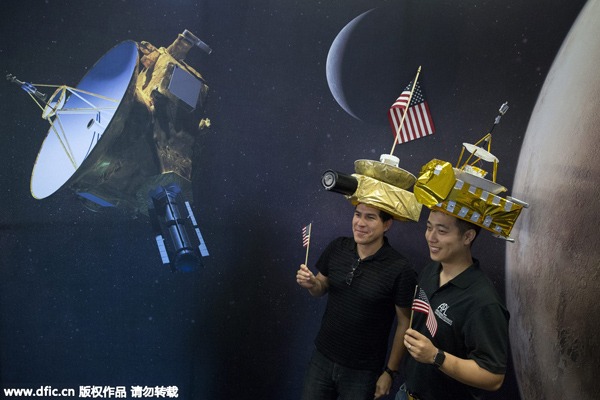Little Pluto bigger than scientists thought
(Agencies) Updated: 2015-07-14 20:57|
 |
|
Graduate student Carlos Nieto (L) and Johns Hopkins University Applied Physics Laboratory (APL) Senior Professional Staff Philip Twu (R) wear hats depicting spacecraft at a countdown to the New Horizons spacecraft's closest proximity to Pluto, at APL, site of the mission operations center, in Laurel, Maryland, USA, 14 July 2015. [Photo/IC] |
As for pictures, the resolution is going to increase dramatically. Until New Horizons, the best pictures of Pluto had come from the Hubble Space Telescope. Hubble did its best from Earth orbit, but managed to produce only crude pixelated blobs of the minuscule world.
The New Horizons spacecraft is the size of a baby grand piano with a salad bowl - the dish antenna - on top. It will come closest to Pluto at 7:49 am EDT (1149 GMT) Tuesday. Thirteen hours later, around 9 pm EDT (0100 GMT), flight controllers will learn if everything went well. The spacecraft will have sent the confirmation signal 4{ hours earlier; that's the one-way, speed-of-light, data-transit time between New Horizons and Earth.
Stern expects "a little bit of drama" during closest approach, when the spacecraft is out of touch with ground controllers. New Horizons cannot make observations and send back data at the same time, so scientists opted for maximum science during those most critical hours.
Pluto is the largest object in the so-called Kuiper Belt, considered the third zone of the solar system after the inner rocky planets and outer gaseous ones. This unknown territory is a shooting gallery of comets and other small bodies; every time one of these wayward objects smack one of Pluto's five known moons, the ejected material ends up in orbit around Pluto, thus the debris concern. An extension of the $720 million mission, not yet approved, could have New Horizons flying past another much smaller Kuiper Belt object, before departing the solar system.






